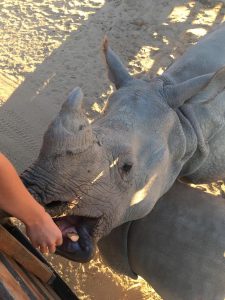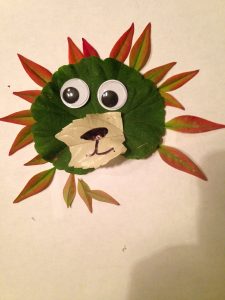Zoo InternQuest is a seven-week career exploration program for San Diego County high school juniors and seniors. Students have the unique opportunity to meet professionals working for the San Diego Zoo, Safari Park, and Institute for Conservation Research, learn about their jobs, and then blog about their experience online. Follow their adventures here on the Zoo’s website!
 Have you ever spent the day with a rhino? How about a giraffe? Roger Petersen and Torrey Pillsbury are Senior Mammal Keepers at the San Diego Zoo’s Safari Park, and it is their job to spend every day with the animals out in the expansive exhibits! They make sure the animals always have plenty of food and water, and when the animals are done eating, they become professional pooper-scoopers! If you thought picking up after your dog was a chore, imagine having to clean up the poop from close to 4,000 animals! With their food, they will often give the animals treats. Rhinos love to feast on buckets full of apples while giraffes especially enjoy acacia leaves. They will never stop eating as long as there are more treats! The last part of their job is to count and catalog each animal. But if there are 4,000 animals, how can you identify each individual? The animals are actually given unique identifications when they are young. Basically, they wear different color earring like tags that, along with notches on their ears, give each animal a unique identification number. Who knew you could identify animals just by their ears!
Have you ever spent the day with a rhino? How about a giraffe? Roger Petersen and Torrey Pillsbury are Senior Mammal Keepers at the San Diego Zoo’s Safari Park, and it is their job to spend every day with the animals out in the expansive exhibits! They make sure the animals always have plenty of food and water, and when the animals are done eating, they become professional pooper-scoopers! If you thought picking up after your dog was a chore, imagine having to clean up the poop from close to 4,000 animals! With their food, they will often give the animals treats. Rhinos love to feast on buckets full of apples while giraffes especially enjoy acacia leaves. They will never stop eating as long as there are more treats! The last part of their job is to count and catalog each animal. But if there are 4,000 animals, how can you identify each individual? The animals are actually given unique identifications when they are young. Basically, they wear different color earring like tags that, along with notches on their ears, give each animal a unique identification number. Who knew you could identify animals just by their ears!
The exhibits are split up into a few separate sections including the Asian Savannah and the African Plains. This allows the animals to be surrounded by other animals from their native habitat. A rhino from Asia would never see a giraffe from Africa in the wild! This helps to make their habitat as natural as possible. In the exhibits, you can find all sorts of animals besides just giraffes and rhinos. You can see numerous species of hoofstock, or animals that have hooved feet, such as antelope and deer. They even have wild cattle! Along with mammals, there are also certain species of birds like the heron and ostrich. However, Mr. Petersen and Mrs. Pillsbury only work with the mammals at the park, and therefore not the birds since birds are not mammals.
While Mr. Peterson and Mrs. Pillsbury care for many of the animals, one of their favorite animal is a rhino named Bhopu. Bhopu is an extremely friendly, male greater one-horned rhino. This species of rhino is native to Asia, and can therefore be found on the Asian Savannah. Bhopu is the father to many young rhinos at the park, including baby Anandi. Anandiś name mean “joyful” in Hindi, which suits the young, playful calf. The interns got the chance to meet and feed Bhopu and Anandiś mother, Alta! If you go to the Safari Park, you might get to feed them too!
Although Bhopu is living a happy life, rhinos like him are disappearing from the wild. They are an endangered species, which means they are at risk of going extinct in the wild. If this happens, there won’t be any more greater one-horned rhinos left in the world! Rhinos aren’t the only animals at the Safari Park in danger either. In fact, many of the species at the park are endangered, or are already extinct in the wild. But don’t worry, because there is still hope! You can help make a difference by supporting the San Diego Zoo and Safari Park along with other conservation organizations that are working towards saving these species. Even visiting the Safari Park and sharing the information you learn can help make a difference!
Are you ready to make your own Safari Park with just the supplies outside in your own backyard?! Keep reading to find the instructions on how to make Safari Animals with just some glue and leaves!
What you’ll need:
- Leaves of differing sizes collected from outside
- Liquid glue
- Googly eyes (optional)
- Sharpie (optional)
How to make a giraffe:
Step 1: Collect the assorted leaves that you want for your animals from your backyard or neighborhood
park. For a giraffe, you want multiple long, thin leaves, one  rather large, oval leaf, and a smaller, oval leaf.
rather large, oval leaf, and a smaller, oval leaf.
Step 2: Place a SMALL amount of glue on the tip of the longest leaf (the neck of the giraffe).
Step 3: Place the small, oval leaf (the head of the giraffe) on the glue. Use your hands, push the two leaves together so the glue can dry.
Step 4: Repeat the gluing process with each of the four shorter, thin leaves (the legs of the giraffe) and glue them to the large, oval leaf (the body of the giraffe). Then glue the lower tip of the neck to the body.
Step 5: Add any remaining details you wish using either googly eyes, sharpie, or additional leaves.
How to make a lion:
Step 1: Collect the assorted leaves that you want for your animals from your backyard or neighborhood park. For a lion, you want a big, circular leaf, multiple small, pointy leaves, and one smaller, oval leaf.
park. For a lion, you want a big, circular leaf, multiple small, pointy leaves, and one smaller, oval leaf.
Step 2: Place a small amount of glue on one of the small, pointy leaves (a part of the lion’s mane). Glue piece to the big, circular leaf (the lion’s head)
Step 3: Repeat until the lion has a full mane.
Step 4: Add any remaining details you wish using either googly eyes, sharpie, or additional leaves.
Sara, Kid’s Corner
Week Six, Fall Session 2016


